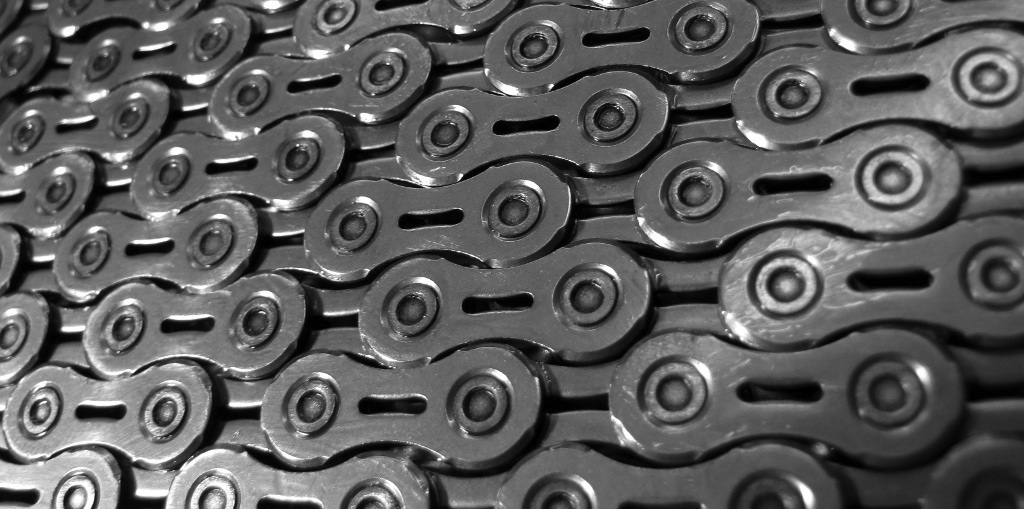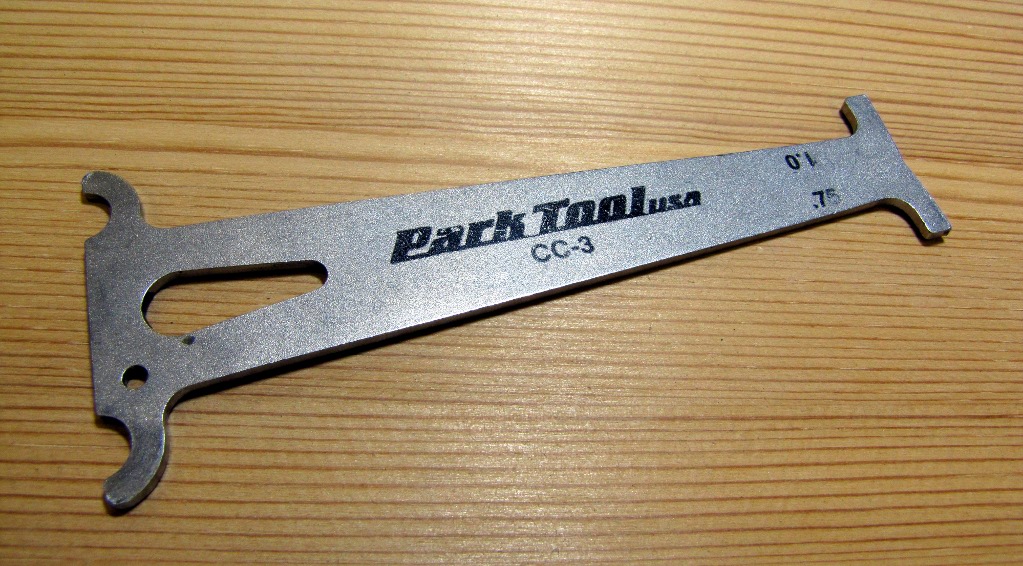(Originally published 16th October 2011)
When we service your bike, things like oils, grease and hydraulic fluid are included in the price. However, some things aren’t included and the most common extra charges are for brake pads, chains and cassettes.
The brake pads are fairly self-explanatory, and you’ll certainly notice if they’re not replaced in time. But it’s not always clear why the bike’s chain, and sometimes the cassette, needs replacing.

As a bike chain is used, something called “chain stretch” occurs. This isn’t a great term for it, because the chain parts don’t actually stretch. At each point where the chain pivots, the constant rub of metal on metal starts to wear the parts away. Although this happens very gradually, this wear means that that pivot point starts to become a little looser. As it wears down, the distance between two consecutive chain rivets becomes very slightly further apart.

The image above shows a very worn chain link and a brand new link. You can see the wear on the rivet, the inside of the roller and the inner edges of the inner plates.
The chain and the cassette (the set of sprockets on the rear wheel) are designed to align perfectly with each other. When both are new, this is what happens; the teeth on the sprockets all mesh equally with the links on the chain, and the force you put in when pedalling gets spread evenly to each tooth in contact with the chain.
But as the chain wears, the length of each link gets very slightly longer. Only by a tiny amount, but this can mean that the pedalling force gets transferred unequally to the sprocket on the back wheel. Because of the way the chain transfers force to the sprocket’s teeth, the teeth at the “bottom” of the sprocket will have more force on them than those at the “top” at any time in the sprocket’s rotation. In turn, this wears down those teeth very slightly. As the teeth wear down, they match the wear of the chain, the chain’s load is spread more evenly across the teeth and the wear lessens.
This isn’t a huge dramatic process (unless your components are made of very cheap metal, or you run your chain dry), but it is a gradual process that occurs steadily all the time you use the bike. In time the chain, and also the cassette, become slightly worn.

I use a very handy tool to measure this “chain stretch”. When new, all bicycle chains will measure exactly 1″, 25.4mm, across one link. (“one link” is the repeating unit – one inner pair of links, one roller, one outer pair of links, another roller). As the chain wears, the very slight lengthening of each link is hard to measure but, because it usually happens evenly over the whole chain, one can measure the lengthening over several links. The tool actually measures from roller to roller, so gives a better measure of the effective elongation of the chain.
The chain tool pictured above is inexpensive and fairly foolproof and I’ll often refer to it as the tool that determines whether the service is going to be a little more costly or not! One end hooks into the chain and the other end will fit into the chain further along if the chain has “stretched”. It has two carefully measured sides, one that will drop into the chain if it’s 0.75% longer than when new and one that drops in at 1% total elongation. Those are important measurements.
Most chain manufacturers recommend that their chains are replaced when they have elongated by 0.75%. Because the chain wears slightly faster than the cassette, this is the point where you can usually just replace the chain (and not the cassette) if both were new to start with. As an aside, if you’re fairly meticulous about swapping chains regularly, you can usually get through two or three chains for every cassette.
Once the chain wear is approaching 1% “stretch”, it’s usually time to replace the cassette as well. Because the teeth on the cassette will have worn down to more or less match the chain wear, if a new chain is fitted to a worn cassette, it won’t mesh properly and may jump or skip, especially when changing gear. Conversely, if a new cassette is used with a worn chain it will also mesh and change gear badly and the cassette will wear much faster than usual. As chains are less expensive than cassettes of equal quality, it’s much more economical to replace them before you need to replace both.

The next logical question, of course, is “if my chain and cassette are worn but working well together, why do I need to replace them at all?”
There are two answers to this. One is, in turn, to reduce wear on your chainrings, the big cogs that the pedals directly drive. The teeth on these won’t usually wear as fast as the teeth on the cassette, because the pedalling forces are spread over more teeth on the chainring. A worn chain will still lead to unequal distribution of force on the teeth on the chainring and will wear the teeth down in the same way the cassette wears. But usually if the chain is kept well below 1% “stretch,” most chainrings will outlast several chains and cassettes.

The second answer is simply that eventually the teeth on the cogs will wear out. I was asked to “have a look at” the bicycle pictured above because “the gears are slipping”. When people tell me this, it’s usually because the gears aren’t properly indexed and the chain is jumping between sprockets, but this chap’s chain had actually begun to slip straight over the cogs whenever he put any pressure on the pedals! There simply wasn’t enough material left on the cogs for the chain to grip on to, so it was jumping over the teeth. Unfortunately for this bike it needed a new chain, new cassette and a new set of chainrings, which worked out more expensive than the bike itself and he chose to scrap it.
The moral of his story? Replace your chain regularly, keep your bike running for longer…

